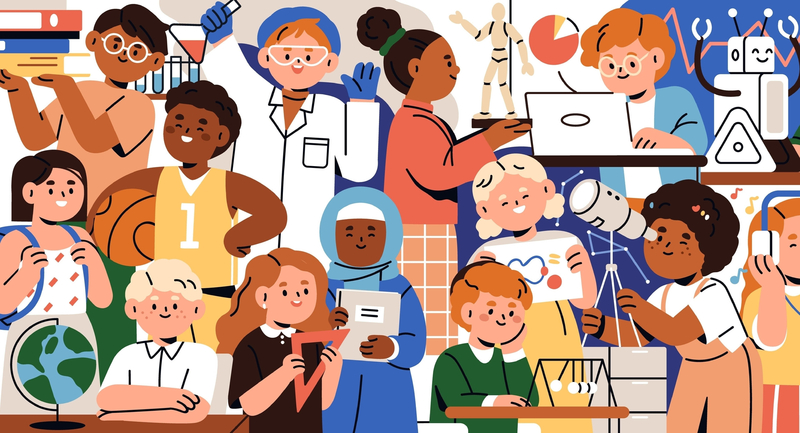Educator and psychologist John Dewey (1916) said that people do not learn from experience alone, but from reflecting on experience. As a teacher of Chinese at an independent school, I have followed Dewey's advice and reflected more intentionally on the materials I have created for my courses—setting out to provide more personalized instruction and assessment. How can I better help each student reflect on his or her learning and become a more productive learner? How can I build each student's individual passion, creativity, capability, and sense of purpose using my Chinese curriculum as a platform?
With these questions in mind, I redesigned a project that I have been assigning to my Chinese language students for the past three years, which led to increased student engagement and improved project quality. Students showed more creativity and responsibility on this project as they combined their knowledge of Chinese with their personal interests and passions.
Project Revamp
Personalization matters in education. As an independent school educator, I appreciate how most schools like mine provide a supportive and tight-knit community for faculty, staff, and students to get to know one other as people. In my subject area, I often work with small class sizes, which allows me to give my students more personal attention in and out of class. However, from both personal and professional experiences, I know that personalized education—even in an accommodating school environment—still needs to be done intentionally and purposefully.
My "One Big Thing" project is a project-based learning experience that asks each student to develop one passion, interest, or idea related to an aspect of Chinese culture and using Chinese language. For instance, students might create a 3-D map of China's indigenous wild animals or conduct a study of Chinese calligraphy. The project's objectives align with my school's institutional focus on developing students' goal-setting capabilities, creativity, and sense of purpose. The assignment also counts as a major assessment for the course.
Although most of the students who completed this project in the past loved it because it offered them choice and autonomy, it was not perfect. Because students were completely in charge of their projects, it was too personalized, in a way, for all students to be held accountable. There were terrific projects, but students who lacked organization skills or discipline could get away with doing the minimum amount of work. I wanted to redesign the project to maximize its potential for effective and productive personalization.
As I reevaluated my previous project plan, I consulted with colleagues from within and beyond my school about their project-based learning experiences. What follows are the changes I made to the "One Big Thing" project design last school year.
Allow for a Longer Ideation Phase
Compared with previous "One Big Thing" projects, I decided to extend the ideation phase—allowing students more time to generate, develop, and test ideas. Students received the project assignment one week before spring break and spent that week brainstorming their project ideas with me and with one another. During spring break, students had no other Chinese homework but to finalize their project plan and complete a contract, which required them to describe their project, establish goals, and set deadlines. After students returned their contracts and I approved them, they started to work on their projects.
I believe that the three-week ideation phase was time well spent because good ideas and plans take time to be developed, refined, and if necessary, redone. University of Pennsylvania professor Adam Grant (2016) goes so far as to say that procrastinating can be beneficial because ideas often get better and clearer the more we gather feedback and go back to the drawing board.
That being said, although I encouraged students to rethink their projects in the ideation stage as they weighed resources and potential obstacles, once they signed their contracts, I expected them to commit to their plans.
Provide Examples for Inspiration
Instead of letting students brainstorm completely on their own, I introduced the "One Big Thing" project using a list of high-quality projects completed in the past. Several students subsequently designed creative projects in categories similar to those used by students who came before them, which created a healthy competition as they aimed to improve on what other students had done. For example, two students built bridges, as a previous student had, but in very different ways. Another student constructed an architectural model of a Suzhou garden in a different style. Seeing prior examples did not inhibit students' originality, but rather jump-started their imagination and encouraged their ambition.
Personalize Programming
Several students used their "One Big Thing" projects to elaborate on elements of the curriculum that we had already completed in class. For instance, a few students expanded on past presentations about the eight regional Chinese cuisines to cook elaborate meals or explore authentic Chinese cuisines in New York City. Two students created a sophisticated music video in Chinese inspired by another Chinese music video I had shown in class. Another student wrote a hiking guide in Chinese prompted by the itinerary for an upcoming school trip to Hong Kong and Taipei, Taiwan. One other student wrote a children's book in Chinese inspired by the "Story of Nian," which students had read shortly after the Lunar New Year.
Although I did not plan these class and school activities around the "One Big Thing" project, I did intend for the various resources to appeal to students with different interests. Any personalized teaching and programming—for whatever purpose—protects and nurtures students' acceptance and expression of individuality.
Invite Frequent, Actionable Feedback from Multiple Sources
Timely and actionable feedback is key to effective learning and student growth, and this general rule applies to personalized project-based learning as well. One of the most satisfying changes I brought to the "One Big Thing" project was to require all students to share their weekly progress with the class, instead of just with me. This practice motivated students to devote substantial time and effort to their weekly work because they cared about what their peers thought. Such sharing also allowed for regular feedback from multiple perspectives.
As is often the case, feedback from peers is typically highly actionable, as students genuinely want to help their friends improve their work. Peers also tend to better understand one another's ways of thinking. In this way, feedback from both their teacher and classmates helped students adjust their goals and priorities for the next steps.
Design a Collaborative Evaluation Rubric
The assessment criteria for the "One Big Thing" project had always differed from other assessments because the students themselves decided how their final products would be assessed. As I revamped my project design, however, I realized that having the students be the sole evaluators of the final product is only part of the solution. The teacher's expectations should also be prominent in the assessment criteria. Therefore, I updated the evaluation rubric into a collaborative authorship: I created half of the rubric (addressing elements such as timeliness of work, quality of the research, public speaking, presentation visuals, and expected amount and sophistication of Chinese language used), and students generated the other half of the rubric, which was geared toward their specific projects.
Although this last change may sound counterintuitive to the goals of personalized education, I believe that it reflects high expectations from the teacher—and honors the tenets of personalization. Personalized education, to me, requires a highly intentional design. Reinstating teacher authority in the evaluation rubric was an experiment, yes, but it was not an accidental decision. Instead, I decided to make this change on the basis of careful reflection of past experience.
In the end, the quality of the projects that used this collaborative rubric proved my experiment successful, and I derived a new understanding of so-called "personalized" education: Although it gives students a greater sense of agency in their own learning, by no means does it relieve teachers from our important roles as guides, advisors, facilitators, and expectation setters. In a personalized education environment, teachers are more appreciative and supportive of students' individual strengths and goals; they can—and should—expect more from the students. High expectations, such as those embodied by a collaborative evaluation rubric, go hand in hand with strong support. That may well be a formula for success as schools strive for personalized education.
An Individualized Education
I introduced the redesigned "One Big Thing" project in early March. By the end of the school year in late May, a range of satisfying—and some outstanding—final products greeted me. These products spoke to students' individual interests and passions. About 95 percent of the projects either met or exceeded my high expectations. The changes I made in redesigning the project were effective; of course, the success of that year's projects was also due to the amazing commitment and talents of the students themselves.
In addition to the previously mentioned examples, some of the outstanding final products included a skyscraper designed for an actual lot in Shanghai, a re-creation of the printing press (one of China's four great inventions), a cello performance of Seven Tunes Heard in China by Bright Sheng, and paintings of the Yellow Mountain and Hong Village in Anhui Province.
Moreover, the students' sense of enjoyment was apparent as many of my 6th graders asked me multiple times whether they could do the project again in 7th grade. (The answer was yes!) It was gratifying to see them find confidence in themselves and experience the joy of learning through the "One Big Thing" project.
I started to talk more about my project with colleagues and presented in teacher groups as well as at other school events. I shared my students' work on campus and through social media. I even contributed to my school's marketing and fundraising efforts by highlighting some exceptional final products. I wanted to promote personalized project design—and redesign—beyond my own classrooms.
Personalization, when done right, honors student differences and builds students' ownership of their learning (Martin & Bunting, 2015). It also empowers students to know themselves and teachers to know their students. Confucius believed in personalized teaching way back in 500 BCE. He said that teaching should be modified to suit the special requirements of each student (yin cai shi jiao). The same is true today. A 21st-century education should be about individual students, all of them unique.









